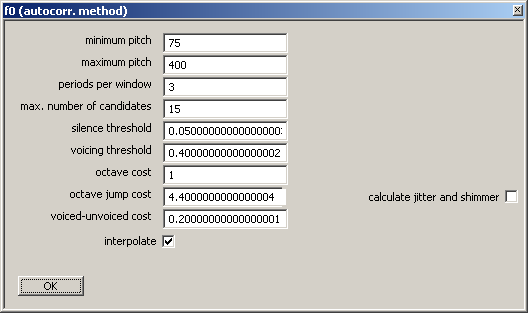F0 (autocorr. method) method
From STX Wiki
Jump to navigationJump to search
F0-Detection using autocorrelation. The algorithm in detail described in BOERSMA, Paul (1993): Accurate Short-Term Analysis of the Fundamental Frequency and the Harmonics-To-Noise Ratio of a Sampled Sound. Proceedings of the IFA. Vol 17. pp 97-110. The result is the parameter function F0B(t) which can be saved in the project.
- minimum pitch, maximum pitch
- The lower and upper pitch boundaries in Hertz.
- periods per window
- The number of periods per analysis window.
- max. number of candidates
- The maximum number of autocorrelation candidates for every frame. Note that the number of F0-candidates (including voiceless candidate) is computed for every frame.
- silence threshold
- The value for the computation of the strengths of F0-candidates.
- voicing threshold
- The value for the computation of the strengths of F0-candidates.
- octave cost
- The value for the computation of the strengths of F0-candidates.
- octave jump cost
- The value for the computation of the strengths of F0-candidates.
- voiced-unvoiced cost
- The value for the computation of the strengths of f0-candidates.
- interpolate
- Check this box if samples should be parabolically interpolated for higher precision.
- calculate jitter and shimmer
- Check this box if jitter and shimmer should be calculated.
- The following parameters are only available if calculate jitter and shimmer is enabled.
- expert parameters
- Check this box if you want to set the expert jitter and shimmer parameters.
- period percentage
- The factor by which two periods are allowed to vary. The default is 0.5.
- max corr. candidates
- The maximum number of correlation candidates to consider. The default is 10.
- global peak percentage
- The threshold value for detection of extrema (extrema are detected in relation to the global extremum). The default is 0.1.
